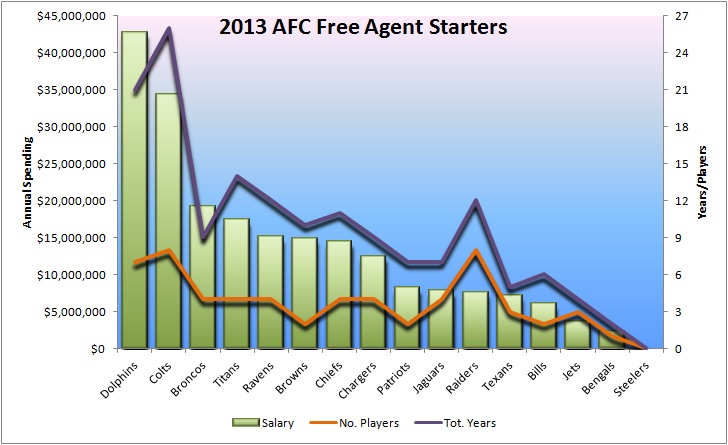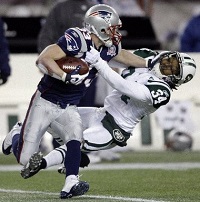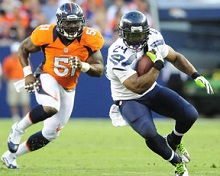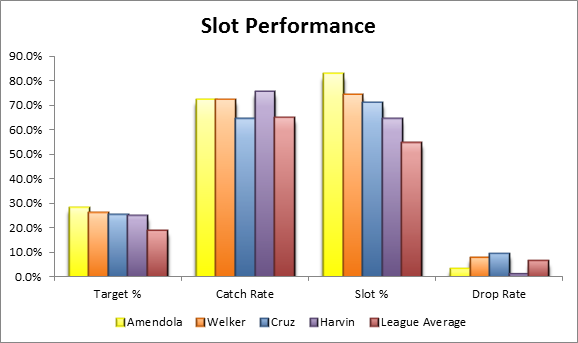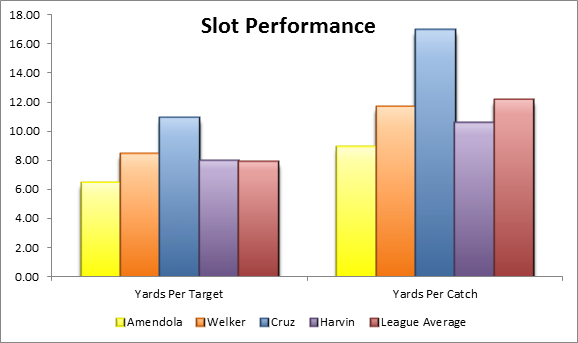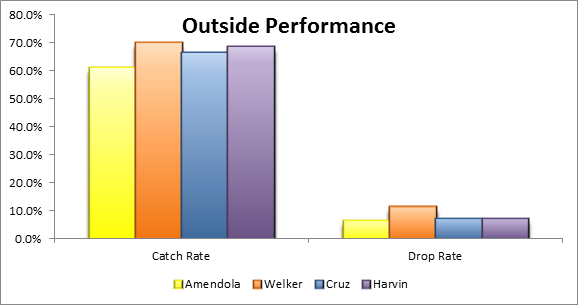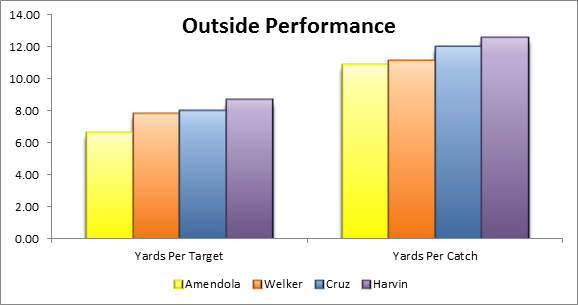[adsenseyu1]
As Ryan continues his excellent State of the Rebuild series, in which he looks at new General Managers and their situations, I thought it might be worthwhile to just give a general overview of the manner in which teams are utilizing free agency to build their starting rosters for the 2013 NFL season. For this I will look at the AFC (I’ll be happy to run the numbers for the NFC if requested) and use the current starting players listed on Ourlads depth charts. Traded players do not count when looking at free agency unless they signed a new contract with the team. For example Chris Ivory of the Jets would count (though he is not listed as a starter) but Alex Smith of the Chiefs would not.
Free agency is often a short sighted approach to building a football team. The NFL is a young man’s game and often the most productive years for a player come during the first six or seven seasons of a career. For some teams this leads to a philosophy of extending draft picks early in their careers. The manner in which this works is that a team, after a players third season in the league (it used to be his second season), extends the player for a period of anywhere from three to five seasons on top of his existing contract.
The benefit to this is that the player is locked up for what are considered his “prime” football years with minimal down the road impact if the player needs to be released for dropoff in performance. The reason the impact is minimized is because bonus money can only be prorated over a 5 year period, leaving the final extension years often clean from a salary cap standpoint. Teams also have a great deal of leverage in these early extension negotiations and can lock up players at below market values. In general you are sacrificing the salary cap benefit of the rookie contract for long term salary cap flexibility. The 49’ers, Packers, and Eagles have all been major proponents of this strategy.
Of course there is risk involved in this strategy. First of all you have a very small sample size of real game action to evaluate the player. For many players you can throw a rookie season out simply due to the immense learning curve of the NFL, leaving a team with just one or two years to evaluate the talent. If the talent busts you are stuck with cap charges you never would have had if you allowed him to play the rookie contract out. This is how the Patriots got into cap problems with Aaron Hernandez. While that is an extreme example it shows the negative side of the early extension.
It can also be a difficult strategy to stick with because GM’s jobs are directly tied to wins and losses and this strategy is a better long term rather than short term strategy. You are sacrificing the opportunity to get better immediately to stay better over a longer period of time, which could lead to some losing seasons early in the philosophical transition. That often leads to a team going in the other direction and looking to build via free agency.
There are various types of building through free agency. There is the more short term enhancement designed to put a “win now” team over the top. The Broncos would be an example of this. They will have nearly $20 million(as measured by annual value) in new talent take the field for them this year, but three of those four players are signed for 2 or fewer seasons. This, in essence, gives the team a great escape if the “win now” team doesn’t win. There is no long term commitment whatsoever.
There is the barren roster situation which would be exemplified by the Raiders. The Raiders are essentially an expansion team and need bodies on the field. They have eight new starters signed as free agents, tied for most in the AFC. They are not signing them to turn the franchise around; it’s simply better than the alternative of the completely unknown undrafted free agent. Of those eight, six will be free agents after this season. It is a stop gap solution with no long term damage.
There are other teams that see free agency as an opportunity to add one or two big pieces to the long term plan of the team. The Browns and Titans would both fit in that category. They added some significant big money players but not to the point where it completely overhauls their roster. These players are not short term solutions either but more admissions of either draft failures or a desire to not spend future draft allocations on these positions.
Finally you have the complete rebuilding approach. I find this to be the most fascinating to watch unfold because the expectations are not so much to build on what is in place but to turn a franchise completely around in a very quick manner. Failure at the early stages of this process often lead to significant salary cap damage down the line. This strategy is completely opposite to the “extend early to avoid the cap pain late” approach. Teams that build this way often do not have a happy ending when the 28 year old free agent makes the turn past 30 and they have all kinds of guarantees or bonus prorations in their contracts. What makes this even more difficult is that you are not putting one or two parts into an existing system but multiple pieces. With limited practice time in the preseason it can leave units of 11 that need to function as 1 right out of the gate struggling for answers on the field. By the time they figure things out the season could be lost and GM’s jobs will be in jeopardy.
The two AFC teams utilizing this strategy this year are the Miami Dolphins and Indianapolis Colts, though there are differences to both internally in the way that they approached this. Miami is one of the most unique attempts at a quick rebuild that I can recall. They have more or less been waiting for the last two years for contracts to run out so that they had significant money to spend. Miami doled out over $42 million in annual salary to other teams’ free agents. That is nearly $8.5 million more than the next closest team. They will have 7 new starters this year, nearly 1/3 of their starting roster.
What makes their situation even more unique is that for all this money spent, $13.5 million of it is just for one year rentals. That $13.5 million represents the contracts given to TE Dustin Keller, CB Brent Grimes, and RT Tyson Clabo. Normally you would expect this more on a “win now” team where you go all in on a few short term pieces, but the Dolphins have shown no signs of being that type of team. They have been a steady as a rock 6 to 7 win team since their trip to the playoffs in 2008.
They also have five other starters in their walk year (Randy Starks, Paul Soliai, Chris Clemons, Koa Misi, and Richie Incognito) which could keep the Dolphins in line for another major overhaul in 2014. With a good deal of cap room to carry over into 2014 and some wiggle room to restructure existing contracts, Miami could conceivably go on a large spending spree again in 2014, potentially under a new GM if the team fails in 2013. So it’s not really a big window of opportunity for the team as presently constructed but more of a one year vision with an open window to improve internally and externally in the future.
The Colts are different. They have taken an approach that you can take a relatively young overachieving team, and I’m not sure any team has ever overachieved more than the Colts last season, and quickly take it from the learning stages right into the advanced playoff stages. Indianapolis will have 8 new starters in 2013, 5 of whom are signed for 4 or more seasons. They committed 26 seasons to these 8 players so this was a long term plan, not a short term fix.
But the Colts are also making a leap of faith on the talent they acquired. These players are not so much proven talents as they are key backups now expected to start. The 8 players only combined for 72 starts in 2012. S LaRon Landry and RT Gosder Cherilus are really your only true proven starters. Almost everyone else the team signed long term comes with a huge “buyer beware” sign and the decisions left a number of people around the league wondering why they paid so much for some of the players.
That said I would consider this a more traditional approach to building via free agency with long term deals as the centerpiece. Normally teams might wait one more season rather than right after the rookie year of a number of key pieces but the Colts are young and cheap enough to where this may just be the prelude to the main event which could take place in free agency in 2014. They will be tough to outbid next year if they want to add more pieces.
I do think that many teams will watch the success or failure of the Colts and Dolphins very closely. There are a number of teams that are going to have significant cap room next season and what could be impatient owners and/or fanbases that want to see results fast. These teams include the Raiders, Jaguars, Jets, Browns, and Bears. If the Dolphins can go from a 7 win to an 11 win team it is going to be hard to state that you want to avoid free agency and build via the draft on a 3 year plan. But if Miami goes 7-9 again and the Colts fail to make the playoffs it will likely be another reason to not go wild in free agency.
A lot may hinge on these types of teams besides free agency philosophies. Spending in general was down last season on most positions other than QB and WR. The flat salary cap has made some teams a bit more cautious than they were in the past with their spending and as a result free agency in 2013 was almost a non-event outside of a handful of contracts. Players need some of these big money contracts to actually result in improved won-loss records and playoff success to convince teams that spending is just as important as drafting.
I’d actually say it is far more important to the players to see players like Mike Wallace and Paul Kruger help turn the fortunes around of their franchise than it would be for a bargain chip like Wes Welker to push the Broncos to the Super Bowl. While a player like Welker would show that you can enhance your results by participating in free agency, his next to nothing contract would still signal that teams should put low caps on their offseason evaluations. If the big money items make a meaningful splash more bidding wars could ensue.
The following chart illustrates the annual amount spent per team on 2013 starters that came via free agency. The two lines show how many players were signed and how many total years were potentially invested in those players. If you would like to see an overview of the NFC feel free to send me an email.
[subscribe2]
